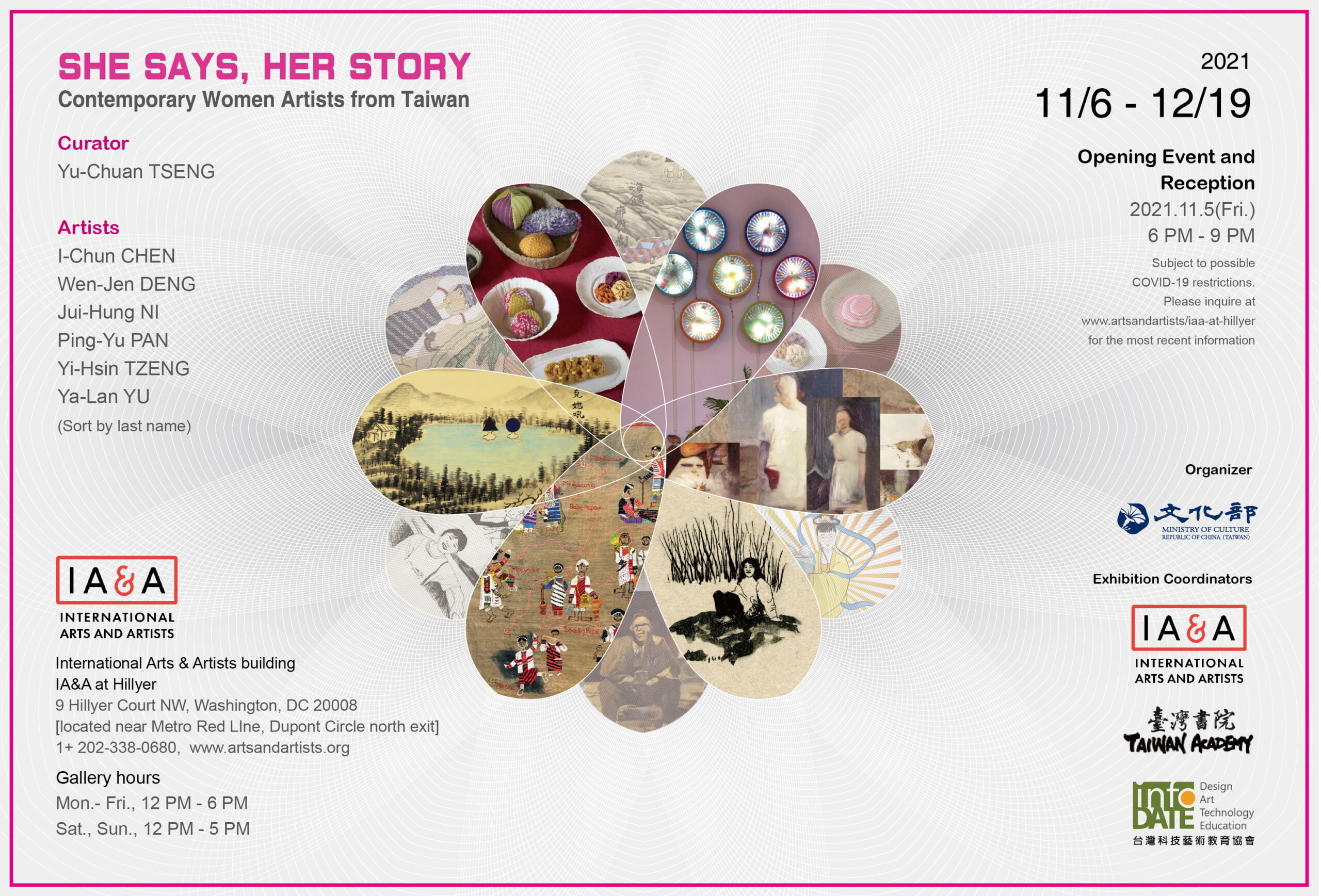She Says, Her Story-Contemporary Women Artists from Taiwan
她說・她的故事-台灣當代女性藝術家聯展
She Says, Her Story- Contemporary Women Artists from Taiwan
Exhibition Dates: 2021.11.6(Saturday) – 12.19(Sunday)
Curator:Yu-Chuan TSENG 曾鈺涓
Artists: I-Chun CHEN陳依純、Wen-Jen DENG鄧文貞、Jui Hung NI倪瑞宏、Ping-Yu PAN潘娉玉、Yi-Hsin TZENG曾怡馨、Ya-Lan YU游雅蘭 (Sort by last name)
Opening Event and Reception:
2021.11.5(Friday), 6 PM until 9 PM.
Subject to possible COVID-19 restrictions.
Please inquire at www.artsandartists/iaa-at-hillyer
for the most recent information
Venue
International Arts & Artists building
IA&A at Hillyer
9 Hillyer Court NW, Washington, DC 20008
[located near Metro Red LIne, Dupont Circle north exit]
1+ 202-338-0680
Gallery hours:
Mon. – Fri., 12 Noon through 6 PM
Sat. and Sun., 12 Noon through 5 PM
Curatorial Statement by Yu-Chuan, TSENG
In the 1930s, the term ” women artist in the bedroom” was used to define female artists in Taiwan. By the 1980s, male monolithic views gave way to broader social perspectives, and a heightened female consciousness. Art organizations were formed to provide institutional support for female artists, leading to the expectation that women would reclaim their power and become critical of male domination. Likewise, women were expected to create large scale paintings and sculpture that embodied the same ambiguity and tension as their male counterparts, suppressing their corporeality in favor of universal art standards.
In the 1990s, female artists in Taiwan express an awareness of their own bodies and their gender. A bold and intense exploratory consciousness is evident in the use of symbols like fruits and flowers that can be read as “signs” of insecurity in the relationships between men and women, and the suppression of women in a morally imprisoned society. In recent years, Taiwan’s female consciousness gradually evolved into a strategy of intervention, extending self-expression and female embodiment to social engagement and cross-disciplinary cooperation.
In this period of transformation, female artists supersede the constraints of society and the conventional roles of women. Rather than tell stories about their depression and discrimination, the female gaze provides an intuitive and critical intervention into social issues. The search for “her” story is conveyed through careful observation and investigation into the creative and practical power of women. Women write history by telling “herstory.” In this kind of social praxis, women artists offer different viewpoints and a consciousness that is unique to the narratives of female life.
Six female artists, I-Chun Chen, Wen-Jen Deng, Jui Hung Ni, Ping-Yu Pan, Yi-Hsin Tzeng, and Ya-Lan Yu, of different ages (30-50 years old) and different identities (Aboriginal, Hakka, Taiwanese, Same sex lover), are invited. Employing the use of videos, paintings, prints, woven fabrics, soft sculptures, and light boxes, they express their observations and explorations as they relate to their personal lives and the stories of their grandmothers, mothers, and friends.
I-Chun Chen searches for the story of her grandmother “Wang- Shih” on Google, Google Maps, and Wikipedia. What she discovers is a sad story about a prestigious family that abandons a young girl. The name “Wang-Shih” means “Raise children casually” in Taiwanese. Ping-Yu Pan uses recipes to unravel the emotional connection to her mother and to explore the “love” and “heart” of the family. Ya-Lan Yu uses printmaking to reproduce a photo of her mother shortly before her death. In the process of viewing, selecting, making plates, and printing, she repeatedly searches for the impressions and memories of her mother when she was alive. Wen-Jen Deng discovered that her maternal family was Taiwanese plains aborigines – Pingpu. She begins with the subjects of Taiwan’s historical events, which leads to a deeper exploration of aboriginal culture and ethnic integration issues. Jui-Hung Ni, who is part of the i-generation, observes women of this new era. She uses humor, creative techniques, and seven fairies from Chinese myths to inform her depictions of career women as psychedelic turntables. Yi-Hsin Tzeng uses traditional Chinese horizontal scroll landscape paintings to capture a journey with her companion. The landscape depicts a national park along Highway15 in the U.S. West, which invites viewers to participate in their private memories.
From this body of work, the artists reveal the joy and sorrow of Taiwanese women in different life situations. The narrations draw from the subjectivity of memory, time, and space, while looking beyond the limits of when and where they are located. In previous generations, Taiwanese women struggled to express themselves in a male dominated society. Today, female artists are protagonists who respond to the narratives of the past and find relevance in the present. Through analysis, research, and exploration, they find “her” in their memories, meaningful experiences located at the intervals of social time and space.



